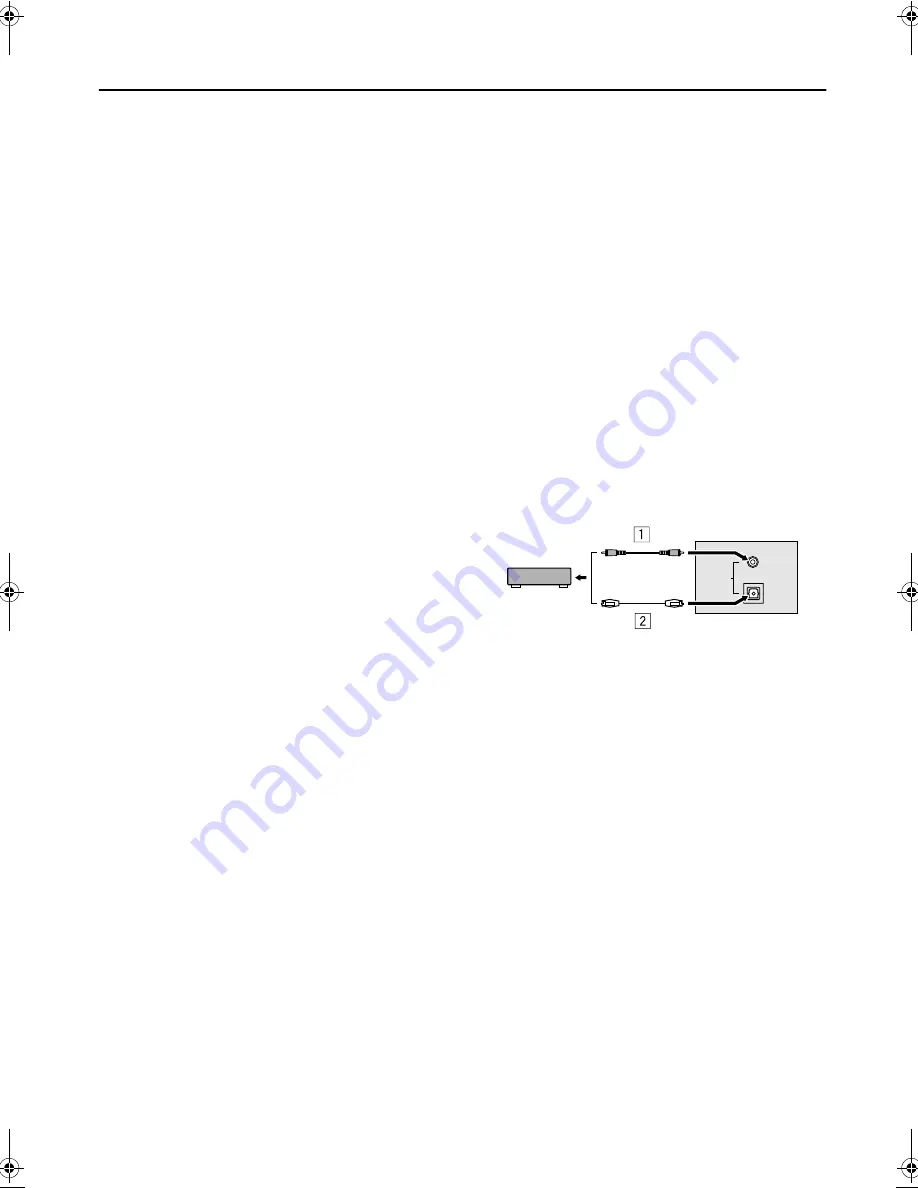
ADDITIONAL PREPARATION
36
AV32/28Z10EU / LCT0918-001A-U / English
Devices which can output the S-
VIDEO signal (Y/C signal) such as a S-
VHS VCR
Connect the device to an EXT terminal other than the EXT-1
terminal.
You can choose a video input signal from the S-VIDEO signal
(Y/C signal) and regular video signal (composite signal). For
details of how to operate the device, see “S-IN (S-VIDEO
input)” on page 23.
T-V LINK compatible VCR
Be sure to connect the T-V LINK compatible VCR to the
EXT-2 terminal. If not, the T-V LINK function will not work
properly.
Note:
• When connecting a T-V LINK compatible VCR to the EXT-
2 terminal, be sure to connect the Decoder to the VCR. If
not, the T-V LINK function may not work properly. After you
have registered TV channels to the Programme numbers
(PR), set the DECODER (EXT-2) function for the
Programme number (PR) to ON in order to unscramble a
scrambled TV channel. For details of operation, see “Using
the DECODER (EXT-2) function” on page 34.
Connecting headphones
Connect the headphones with a stereo mini-jack (of 3.5 mm
in diameter) to the headphone jack at the TV front panel.
Video/sound signal output from the
EXT-2 terminal
You can arbitrarily change over the output of the video/sound
signal from the EXT-2 terminal. It is useful when you want to
dub the video/sound from another device on the VCR
connected to the EXT-2 terminal. For details on how to do this
operation, see “DUBBING” on page 24.
TV output from the EXT-1 terminal
The output of video/sound signal of a TV channel you are
currently viewing is always output from the EXT-1 terminal.
Note:
• Changing over a Programme number (PR) also changes
over the TV output from the EXT-1 terminal.
• The video/sound signal from an EXT terminal cannot be
output.
• Teletext programmes cannot be output.
!
!
!
!
Listening to Dolby Digital
audio
In order to listen to Dolby Digital audio which is recorded as a
Dolby Digital programme source (such as a DVD-video disc),
connect the device and set the DIGITAL-IN as described
below.
Preparation:
• A device (such as DVD player) with a digital output terminal
(coaxial or optical) for Dolby Digital is necessary.
• A coaxial cable or optical cable is necessary to make the
connections. (Not supplied with the TV)
• In accordance with the instruction manual which is supplied
with the device, correctly connect a coaxial cable or optical
cable to the device’s DIGITAL OUT (digital output) terminal
and set the device so that the Dolby Digital audio signal is
output.
• Correctly connect the device to the EXT terminal in
accordance with “Connecting the external devices” on
page 35. However, since the EXT-4 terminal does not work
with Dolby Digital audio, it cannot be used.
1
Connect the device to the DIGITAL
AUDIO IN terminal with a coaxial cable
1
or optical cable
2
.
2
Connect the device and set the EXT
terminal to DIGITAL-IN in accordance
with “DIGITAL-IN” on page 23.
This completes the preparation.
Note:
• When an optical input and coaxial input are input
simultaneously, the optical input takes precedence.
• When the headphones are used, the sound
becomes normal stereo.
• This TV does not work with digital audio signals
other than Dolby Digital audio. If no sound is
emitted from the speakers, cancel the DIGITAL-IN
setting and change to normal analog sound.
• The sound from the EXT terminal set to DIGITAL-IN
is not output from the EXT-2 terminal.
OPTICAL
COAXIAL
DIGITAL
AUDIO IN
Back of the TV
or
AV32Z10EU_Eng.book Page 36 Monday, June 4, 2001 6:12 PM
Summary of Contents for AV-32Z10
Page 45: ...44 ...









































